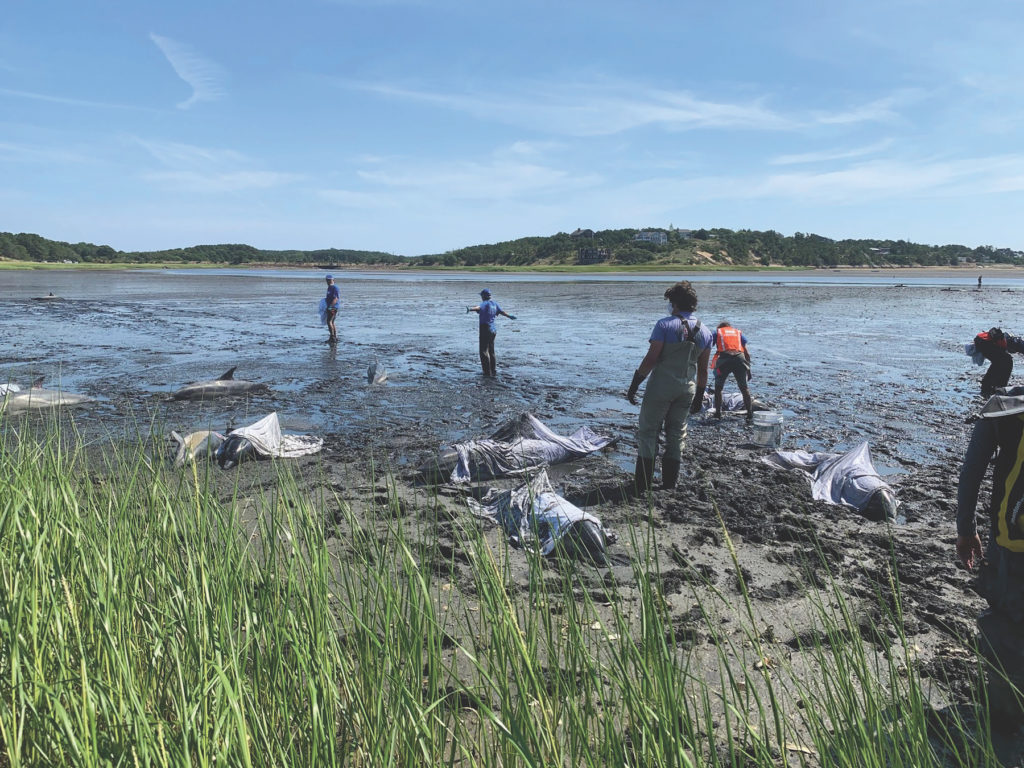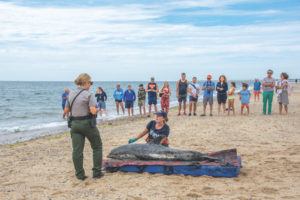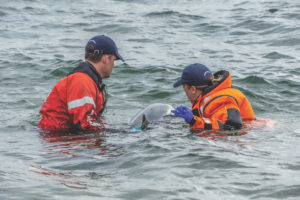
WELLFLEET — Cape Cod is known as a global stranding hot spot for whales and dolphins. Probably no one knows that better than the International Fund for Animal Welfare (IFAW) volunteers on the Outer Cape, whose territory includes a stretch of coastline notorious for strandings.
A quarter century ago, at this time of year, volunteers would be getting ready for winter stranding season. Now, the strandings come all year round.

“Wellfleet is the third largest mass stranding hot spot in the world,” said volunteer Tracy Plaut, who lives in town. “Every year we follow New Zealand and Australia for the number of strandings. Wellfleet is kind of an epicenter.”
In August, 45 Atlantic white-sided dolphins stranded in Wellfleet on the mudflats where the Herring River meets the harbor — a spot known as the Gut.
“With that many animals it was all hands on deck,” said IFAW stranding technician Olivia Guerra, who also serves as volunteer coordinator. “People came from far and wide to help us with that.”
“That was a huge number of animals. That’s not a typical response for us,” said Plaut, who has worked as a stranding volunteer on the Cape and Nantucket for 20 years.
Living on Wellfleet Harbor, volunteer Holly Kuhn gets called “pretty regularly,” she said, and took a call during the August stranding. “We had a report of 25 to 30. It already sounded like a lot,” said Kuhn.
Upon arriving at the Gut, she began numbering and taking photos of each animal. “I ran out of space,” she said.
Volunteer John Beardsley of Wellfleet recalled arriving on the scene. “As far as I could see to the left and right were dolphins,” he said.
Beardsley is familiar with the lay of the land at the Gut. His experience there goes back to his first assignment, in 2011, to locate a deceased minke whale.
“How can it hide a 26-foot whale?” Beardsley recalled thinking as he searched the gut’s dense grass. Eventually the animal was found, and Beardsley was able to return the following day with a team to perform a necropsy.
“It’s not all pretty,” said volunteer Carolyn Castiglione of Eastham, referring to the necropsies. “What the public sees more is the rescues.”
Volunteers are not required to respond to calls of deceased animals, Plaut cautioned.
“A lot of people don’t volunteer to work on dead animals,” Plaut said. “It can be a trigger for some folks.” She explained that most people feel more comfortable trying to rescue live animals than studying the ones who don’t make it. “There’s great need for and great value for both,” she said, “but that does not mean as a volunteer that you must be willing to do both.”
Guerra agreed that the data gathered at strandings, even when rescue is not possible, is a help. “We learn as much, if not more, from the reports of deceased animals,” she said. What is learned might help rescuers find ways to increase survival rates.
More Animals Survive Now
Over the last 20 years, the stranding survival rate has increased from 17 percent to 80 percent.
“We had these preconceived notions of what these animals needed, and that meant just grabbing them and throwing them back in the water when that wasn’t based on any scientific data,” said Plaut. “Over the 20 years that I’ve been doing this work, we’ve completely changed the way we respond.”

IFAW volunteer Larry Bessinger of Eastham has witnessed the improved rescue success rate first-hand. When he began as a volunteer with the Cape Cod Stranding Network 17 years ago, he said, “at a mass stranding there was only one truck and it didn’t have medical equipment.” At the August stranding, 42 animals were saved: 31 of them were herded into deeper water, and 11 were treated and later released.
Castiglione described the IFAW vehicles today as containing “small ERs.”
Volunteers need to be mindful to avoid requiring rescue themselves, as they often work long hours in harsh conditions with large animals.
“We try to pace ourselves,” said Bessinger. And “IFAW keeps an eye on the volunteers.”
Accidents can happen, though. Bessinger recalled escaping unscathed after finding himself under a dolphin cart at Rock Harbor in Orleans.
“The side of the cart I was on hit a soft spot and the cart and dolphin rolled over on top of me,” he said.
Volunteering can have its emotional challenges as well, and rescuers can sometimes spend hours with an animal that medical personnel determine cannot be saved.
“Sometimes all the volunteers will just bail out of the trailer,” said Kuhn.
But good experiences also can occur in the trailer, as volunteer Patty Walsh recalled.
“I cleaned one of the dolphin’s eyes and went back to writing,” she said. “I looked up and the animal was watching me. It was really pretty awesome.”
The size of the stranded marine mammals often calls for many volunteers to lift just one, as happened with the 2017 New Year’s Day stranding of 10 Risso’s dolphins at Chipman’s Cove in Wellfleet.
“They’re averaging just under 1,000 pounds,” said Guerra. “It took at least 20 people to lift one animal.” Despite the holiday, enough volunteers turned out to move and transport the dolphins to a release site.
“We range from rescuing small harbor porpoises up to minke whales,” said Guerra.
Volunteers are required to complete an initial training and to continue that training with additional courses annually.
Gaining the skills to help dolphins is life changing, Plaut said. “You suddenly go from having a wonderful Christmas dinner with your family to being in the mudflats on a freezing cold December night,” said Plaut, “because once you have the ability to help another animal, you can’t say no.”
Guerra expressed IFAW’s appreciation of the volunteers and the vital role they serve on the Cape; the volunteers feel the same way about IFAW.
“One of the most wonderful things about this whole operation is the people you work with — the volunteers, the staff, everybody loves animals,” said Beardsley. “Animal lovers are normally pretty good people.”
For information about becoming an IFAW volunteer go to ifaw.org/action/marine-mammal-volunteer-opportunities.



